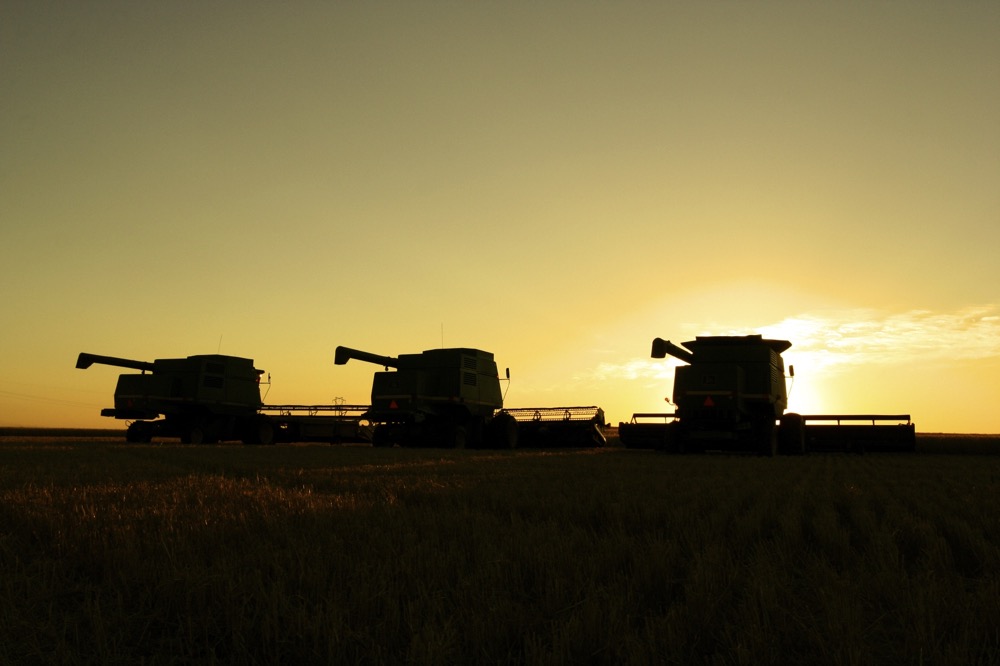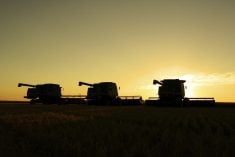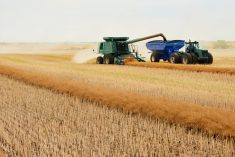Canadian farmers seen planting biggest-ever canola area
By Rod Nickel and David Ljunggren
WINNIPEG/OTTAWA, April 21 (Reuters) – Canadian farmers intend to plant their biggest-ever canola area, exceeding trade expectations, and trim wheat sowings, according to Statistics Canada’s first report on seeding for the year, released on Friday.
The report turned ICE Canada November canola futures negative, dipping 0.4 percent after the report.
Read Also

Saskatchewan Crop Report: Harvest nears completion
Saskatchewan’s harvest was 98 per cent complete as of Oct. 13 before rain and snow fell onto some regions.
Later, at midmorning November was trading at $490.40, down $3.30 (-0.67 percent).
Canola plantings looked set to reach 22.4 million acres, up 10 percent from last year, and surpassing the average trade estimate of 21.3 million acres.
“There’s going to be a lot more canola,” said Shaun Wildman, a Saskatchewan farmer and independent futures trader. “(Forecast acreage) is a little higher than I expected, but I don’t think it’s completely unrealistic. The price signals are there.”
Farmers sowing more canola are likely pulling back on acreage of lentils, barley and durum, he said. Statscan reported that farmers intend to plant much less of those crops.
Concerns about heavy snow in the past week in northern Alberta, where many fields went unharvested last autumn due to wet weather, had pushed canola prices to one-month highs this week.
Fieldwork in Canada has been slow due to cool weather and snow is possible in some areas during the next five days, Commodity Weather Group said on Friday.
Statscan pegged the all-wheat area at 23.2 million acres, down 0.1 percent from last year, but the estimate was bigger than traders and analysts expected.
Statscan’s estimate for more spring wheat seedings was “a shocker,” said Brian Voth, president of farmer advisory IntelliFARM Inc, on a call to discuss the crop report organized by MGEX. Disease problems with last year’s crop left a sour impression on many farmers, he said.
“You struggle to make a decent return on wheat any given year,” he said. “It’s a frustrating crop to grow and market.”
Chicago May wheat futures hit a contract low after the larger-than-expected estimate.
Canada is one of the world’s largest wheat exporters and the biggest shipper of canola, a cousin of rapeseed used largely to produce vegetable oil.
THE FOLLOWING IS THE DIRECT TEXT FROM THE STATISTICS CANADA SEEDING INTENTIONS REPORT
Canadian farmers expect to plant more canola, soybeans and oats in 2017, but fewer acres of durum wheat and lentils, crops that were both at high levels in 2016.
Wheat
Nationally, farmers reported intending to seed 23.2 million acres of all varieties of wheat in 2017, relatively unchanged from the area seeded in 2016. Western producers, accounting for 95% of this acreage, are expecting only a slight increase of 0.4% overall, to 22.0 million acres.
Alberta anticipates wheat acreage to be up 10.0% to 7.4 million acres, a possible record high, but less area is expected to be dedicated to durum, down 8.5% to 1.1 million acres.
Saskatchewan farmers expect wheat area to decrease 2.7% to 11.8 million acres. This is due to an 18.8% drop in acres intended for durum wheat, to an anticipated area of 4.1 million acres.
Farmers in Manitoba intend to plant 2.7 million acres of wheat, down 9.0% from 2016.
Canola
Canadian farmers are expecting to seed more canola in 2017, up to a potential record-high 22.4 million acres (+9.9%).
In Saskatchewan, the largest canola-producing province, farmers anticipate seeding 12.3 million acres (+10.6%) in 2017, compared with 11.1 million acres in 2016. Farmers in Alberta also expect an increase in canola acreage, up to 6.8 million acres, a rise of 14.6% over 2016. These could represent record-high areas for both Saskatchewan and Alberta. Manitoba producers, though, expect a slight decrease, as farmers anticipate seeding 3.1 million acres of canola, down 1.7% from 2016.
Soybeans
At the national level, farmers intend to seed a record 7.0 million acres of soybeans, up 27.2% from 2016.
Manitoba is showing the largest expected increase in area, up 34.6% to 2.2 million acres, another potential record high for this province. Ontario farmers anticipate seeding 3.0 million acres, a rise of 11.4% over 2016, while Quebec’s acreage is expected to grow to a possible record high of 926,600 acres, up 15.4% over 2016.
Barley and oats
Canadian farmers across almost all provinces report that they intend to seed less barley in 2017 (-8.0%), driving down acreage to 5.9 million acres nationally.
On the other hand, areas seeded to oats are expected to rise in most provinces (+20.6% over 2016), to 3.4 million acres. The only exception where a potential drop is foreseen is Alberta, where farmers plan to seed 690,000 acres to the crop, a 4.2% decrease compared with 2016.
At the national level, corn for grain acreage is anticipated to rise to 3.8 million acres, an increase of 12.8% over 2016. Provincially, farmers in Ontario expect a 9.6% increase to 2.2 million acres. Quebec farmers reported a similar increase (+9.7%) to 976,100 acres, while producers in Manitoba anticipate seeding 475,000 acres of corn for grain in 2017 (+37.7%).
The March Farm Survey, which collects information on crop planting intentions, was conducted from March 16 to March 31, 2017 and included about 11,600 farmers. Farmers were asked to report their planting intentions for grain, oilseeds and special crops.
Subsequent surveys during the year will provide estimates of actual seeded acreages. Data on final acreages for 2017 will be released on December 6, 2017 and will be subject to revision for two years.
Farm surveys collect data from Quebec, Ontario, Manitoba, Saskatchewan and Alberta at all survey cycles. However, they collect data twice a year (in the June farm survey on seeded areas and in the November farm survey on final field crop production) for Newfoundland and Labrador, Prince Edward Island, Nova Scotia, New Brunswick and British Columbia, which represent between 2% and 4% of national totals. Therefore, Canadian totals for March include carry-over data for these provinces from their preceding November survey, and Canadian totals for July include carry-over data for these same provinces from their preceding June survey.
Release calendar: The dates for upcoming releases of stocks, areas and production of principal field crops are available online.
In this release, percentage changes are calculated using unrounded data.
Data for March 2017 are compared with final 2016 data.














